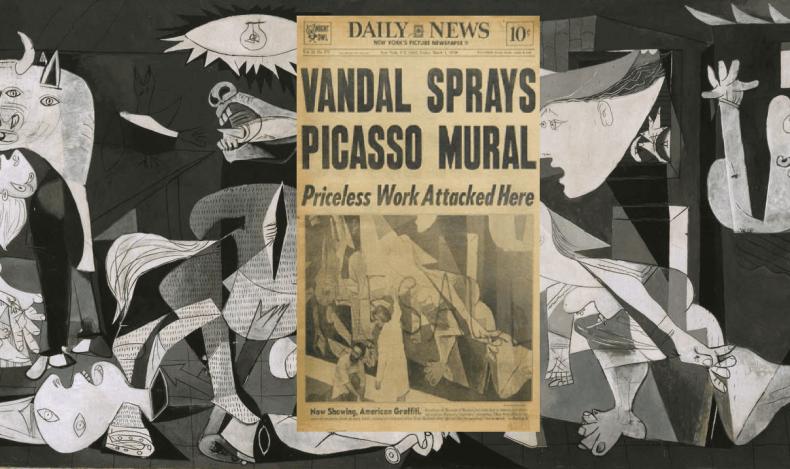
Un artiste peut-il faire acte de création en vandalisant luvre dun autre ? Analyse de 73 cas.
Precise and documented, this work, whose object of study is vandalism exerted on works of art in museums, received the scientific prize L’Harmattan 2021, doctoral series.However, Anne Bessette does not pretend to examine all acts of vandalism, such as these thousands of caresses given on the suggestive forms of sculptures, chewing gums left on tables, different iconoclasms, revolutionary destruction, current tumbles of statuesBecome subjects of scandal, etc..Other works exist on these aspects of vandalism.Beyond exhaustiveness, the author is interested in the social and political challenges of this theme, which cross cultural policies, the relationships of works to the public and the questions of censorship.Anne Bessette does not pretend either to deal with spectacular vandalisms, which are similar to acts of censorship, as was the case for the deterioration of immersion (PISS Christ)))) of photographer Andrès Serrano.His words is limited to works of art, which only overlaps of a portion of a more general vandalism than one could extend to literary, cinematographic and other works, as well as to works produced by women, or forThe feminine cause.)))).
Mais c'est le vandalisme d’artistes à l’adresse d’autres artistes qui l'arrête : coup d’épingle sur la toile d’un collègue, destruction d’une œuvre détestée, miction de Pierre Pinoncelli (spécialiste des happenings)))) dans un urinoir de Duchamp, pour lui rendre sa fonctionnalité, baiser au rouge à lèvres de Rindy Sam sur un Cy Twombly (1977)))), etc.
It was absolutely necessary to clarify these actions, to make them a place in the construction, since the French Revolution, of the sacralization of art, to take the pulse of discussions within the public sphere.This asked to bring up acts to which we pay little attention, but whose intention is quite repetitive: the desire to desecrate the works.
So we are committed to reading a long investigation.Sociology researcher, Anne Bessette has taken the purpose of the relationships of art and cultural institutions.This is how she meets the phenomena of vandalism, in museums.Should they be classified among the psycho-pathological phenomena, and in this case, why;should we inscribe them rather in a conflict that crosses the art world, about the "value of art";Finally, should we treat them rather as "creative vandalisms", a new notion developed by the author?
Help the dispute
If the author does not intend to dwell on all vandalisms, she takes us a little tour of the destruction of works in the world and in history.It brushes aniconism and the condemnation of idolatry, the systematic destruction of holy images with certain eras, in short, the ways of mixing politics and the religious in criticism of powers.
The desire to institute a new symbolic order is often coupled with the eradication of the efficiency of the disputed order.It thus travels a few major actions which, however, including the Banyan's Buddhas affair without too many nuances and the scrollings of statues in 2020, in Europe in Europe.But it is to better distinguish its object from other more common themes.
Because the research company emerges from a rigorous bias: it relates to stigmatized behaviors as "vandals", those of a person, artist, who, for pleasure or wickedness, abyss, destroys one or more works of art.What logic respond these acts labeled by the press or institutions?While confined to the European or North American area, it also examines the terms of receiving these acts, often taken for deviant acts.Finally, she is interested in this creative vandalism of which we have spoken, that is to say in the attacks carried out in an artistic perspective.
Some believe that the museum is a cozy place that gives stability pledges and leaves the quarrels to the door.This is false in terms of old works: regularly damaged or destroyed because of what they embody (spiritual power, condemnation of iconism)))).It is even more false concerning modern or contemporary works.In this case, museums must face contemporary debates as well as the protest within the museum world of this very world, the art world, but also of the arrangements, postcolonial survival, of the lack of attention to genres.

Cases described
The author's approach being sociological, she conducted an investigation, exchanging directly with authors of acts of vandalism and with artists whose works were vandalized.It thus constituted a corpus of 73 media cases. Parmi eux, elle distingue le vandalisme effectué dans une démarche artistique du vandalisme revendicatif (individuel ou politique)))), du vandalisme psycho-pathologique, du vandalisme lié aux images mises en œuvre, du vandalisme ancré dans une critique esthétique, auquel elle ajoute un « micro-vandalisme ».
It gives the list of cases of vandalism, between 1974 and 2014, falling under its object.This list is offered at the end of reading, it closes the work.It has the advantage of being explained.Out of 73 cases of vandalism, 28 concern works of contemporary art, in particular installations or photographs. Les instruments du vandalisme sont répertoriés : urine, baisers, actes avec des objets pris sur place ou des objets de la vie quotidienne (clefs, monnaie trouvée dans la poche)))), colorants, stylos, marteau, barre de fer, hache, solvants, boute-feu.We can still distinguish the objects used to destroy, those used to add something.Few are the cases where the total destruction of the work is the objective of the act.And sometimes, as in the case of kisses, the authors think they do not put a serious damage to the vandalized work.
Among the vandal authors, men are largely represented.All age groups are also between 12 and 77 years old.An important part of the authors exercises a trade in art circles.But the artists infringe little in classic works.
Finally comes the most important: explanatory hypotheses or the words of "vandals".They pretend, in fact, various objectives: to oppose innovative art, to update, to restore it news, to brighten up a painting found sad, to draw attention to the fate of artists, to rise against spendingpublic for such a work, protest on various themes (against environmental pollution, etc..)))).
Thus comes the case of the supporter of realism which deteriorates an abstract work, that of a person wanting to dialogue with the artist, or wanting to add new colors to a work found boring. Puis les cas de protestation créative contre le marché de l’art, contre les profits faits par un artiste sur un thème douloureux, protestation aussi contre l’interdit de la nudité en public (alors que la nudité est constante dans les œuvres d’art)))), contre la renommée d’une œuvre alors que d’autres sont ignorées…
Creativity
Creative vandalism is accomplished on works on display in museums.The act is organized and reflected by an artist. C’est les termes que Tony Shafrazi, après avoir, en 1974, bombé Kill Lies All (« Tuez tous les mensonges »)))) sur Guernica, utilise auprès des gardiens qui l’interpellent.In the same vein, we could come back to Pinoncelli's gesture in the place of Duchamp's work: "I have always claimed and argued that I have never made vandalism" (Interview with theauthor, in 2014)))).
They speak of added value to the work or restoration of its primary function.In any case, the authors of artistic design attacks often conceive their intervention as a form of contribution to the initial work, or of dialogue with its creator.Moreover, they almost always assure that the creator of the work would have agreed with their gesture.
The authors of creative vandalism acts often target works by artists they admire, who inspire them, with whom they wish to interact.Their interest is on the work of creators who have shaken up artistic conventions.What they take for the pretext of their own gesture, in general interventions carried out with bare hands or using materials characterizing artistic activity.
Museum departments make little advertisement around these gestures.As far as watching, for example, the inscription by a young woman on the freedom of Delacroix in Lens, one wonders in view of the distance from graffiti and the table what she wanted to tackle?A symbol of heritage, a well -known work?Unless the person in question has been unbalanced.But we cannot examine all these cases from such a psychiatric angle.
Finally, it appears that certain acts of vandalism are perpetrated in reaction to what the work figuratively represents.This is the subject of the work which is then targeted.The vandal shows its disagreement, even its indignation.General social controversies accentuate the phenomenon, as it goes for the deterioration of a work, thought as macho, by two feminist women, to the tate of London.We then hesitate between vandalism and censorship.This is the case of people who believe they are taking sides against a "blasphemous", "immoral", indecent ", offensive work.This again concerns Andres Serrano, but also other artists.Protests against a work can lead to vandalism.Hence the link between the two actions.The protest is not itself vandalism and we can prolong it in debate to refuse vandalism.To which is added all the same that sometimes, to perform a vandal act, you must have disinvested the work of your aura.A vandal said that it considered that the fame acquired by the attacked work was humiliating for "the real" artists.
Paradoxes
Are there any intervention methods on the works that are legitimate?This would be the case for works with the vocation of intervention. Le public peut être invité à agir sur l’œuvre (comme chez Yoko Ono)))), mais alors on demande que son comportement concorde avec les requisits du musée.
The fact remains that an act of vandalism draws the attention of the media as much to the vandal as to the work.Again, some vandalisms are more raw and more marked in the seal of an ideology.
This is still the case for women's newspapers who have fought for equal rights, effective universal suffrage, etc..The time imposes this attention to us, with the publication of the newspaper of a suffragist, of Hubertine Auclert.A book that was the victim of vandalism of non-climbing in libraries.
However, in many cases, vandalism gives works a paradoxical visibility, as well as the institution that exposes it.We even proposed to the director of the Lambert collection in Avignon, owner of Cy Twombly's work marked by Rindy Sam, to write a screenplay for TVilm.
Christophe Pittet
À quoi sert (encore)))) l’art en temps de crise sanitaire ?, ouvrage dirigé par Christophe Pittet emprunte son titre à une comédienne.How to bounce back, not in a situation of vandalism, but where the world and others no longer exist, that is to say, in times of unequal containment, pandemic ravages, of ecological disaster in progress, when realitywas done...vandal.
Pandemic vandalizes our social relationships.Artists have positive proposals to make to the public, even in these serious times.
À l’époque du premier confinement, Christophe Pittet préparait une cession de réflexion sur le thème : « À quoi sert (encore)))) l’art ? », qui fut annulée (13 mars 2020)))).
The idea was to question the place of art and its function in society, the role of artists in the face of neoliberal policies.Does art participate in resistance against the power of money?A counter-culture?
Everything is swept away, but in April, Pittet decides: we cannot wait, and besides waiting?So he offers participants of the canceled transfer (Pascal Germond, Lysiane Sergent, Jean-Marc Lachaud, Mireille Callu, Nathalie Chaix, etc..)))) de répondre à la question : « À quoi sert (encore)))) l’art… en temps de crise sanitaire ? ».
20 texts, who arrived one by one, dated from the covid period, and which sometimes follow tangible moods.The answer to the question asked will not surprise anyone: art, say the authors, is useless.But by serving nothing, it serves us.
Comedians, artists, philosophers, filmmakers and others answer less to the question of how to create subject to the virus, than to the question of what art can in time of confinement.
The authors do not know how to speak this new world.The works can ultimately do nothing for everyone, and everyone does not seem to be able to do something for the works that could have happened.And screens that have become substitutes for works are nothing but symptoms of distress.







